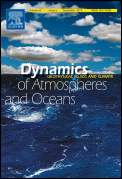
DYNAMICS OF ATMOSPHERES AND OCEANS
Scope & Guideline
Unveiling the Secrets of Atmospheric and Oceanic Interactions
Introduction
Aims and Scopes
- Atmospheric and Oceanic Interactions:
Research on the interactions between atmospheric phenomena and ocean dynamics, including the impact of ocean currents, temperature variations, and wind patterns on weather and climate. - Climate Variability and Change:
Investigating the effects of climate change on oceanic and atmospheric systems, including studies on monsoons, cyclones, and long-term climate trends. - Numerical Modeling and Simulations:
Development and application of advanced numerical models to simulate atmospheric and oceanic processes, including wave dynamics, storm surge modeling, and climate projections. - Biogeochemical Cycles:
Examination of biogeochemical processes in oceanic environments, including the impact of salinity, temperature, and nutrient dynamics on marine ecosystems. - Extreme Weather Events:
Analysis of extreme weather phenomena, such as tropical cyclones, heavy rainfall, and heatwaves, and their underlying mechanisms. - Regional Studies:
Focused research on specific geographical areas, such as the Indian Ocean, Arabian Sea, and Mediterranean regions, to understand localized atmospheric and oceanic dynamics.
Trending and Emerging
- Machine Learning Applications:
There is a growing trend of utilizing machine learning algorithms in climate modeling, prediction, and data analysis, which allows for improved accuracy and efficiency in handling complex datasets. - Impact of Climate Change on Extreme Events:
Research increasingly addresses the implications of climate change on extreme weather events, such as intensified tropical cyclones and changing precipitation patterns, highlighting the urgency of understanding these phenomena. - Marine Ecosystem Responses:
Studies focusing on the responses of marine ecosystems to changing ocean conditions, including heatwaves and salinity variations, are gaining prominence as they are critical for biodiversity and fisheries management. - Integrated Modeling Approaches:
There is a notable shift towards integrated modeling that combines atmospheric, oceanic, and biogeochemical processes, reflecting a holistic understanding of Earth system dynamics. - Regional Climate Impact Studies:
Emerging themes include detailed regional studies that assess the specific impacts of climate variability on local weather patterns, agriculture, and water resources.
Declining or Waning
- Traditional Statistical Methods:
There has been a noticeable decrease in the use of traditional statistical methods for climate analysis, as researchers increasingly favor machine learning and advanced computational techniques. - General Ocean Circulation Models (GCMs):
Research relying solely on GCMs without integration of regional models has waned, likely due to the limitations of GCMs in capturing localized phenomena. - Historical Climate Reconstruction:
Studies focused on historical climate reconstructions have diminished, as the field shifts towards real-time data analysis and predictive modeling. - Single-Variable Studies:
The trend of focusing on single-variable analyses, such as temperature or salinity alone, has decreased as interdisciplinary approaches that consider multiple interacting variables gain prominence.
Similar Journals
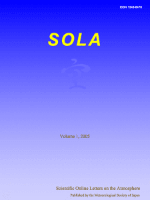
SOLA
Championing high-quality research in atmospheric sciences.SOLA is a distinguished journal published by the Meteorological Society of Japan, focusing on cutting-edge research in the field of atmospheric science. Since transitioning to an Open Access model in 2018, SOLA aims to facilitate the dissemination of knowledge and foster collaboration among researchers from around the globe. With a proud history spanning from 2005 to 2024, the journal has earned a reputation for high-quality publications, achieving a Q1 ranking in Atmospheric Science according to the 2023 category quartiles. Although its H-Index is currently not available, SOLA is recognized in Scopus rankings, standing at #82 out of 148 in Earth and Planetary Sciences, demonstrating its impact in the field. With its headquarters in Tokyo, Japan, and an unwavering commitment to advancing scientific understanding, SOLA serves as an essential resource for researchers, professionals, and students dedicated to exploring the complexities of atmospheric phenomena.
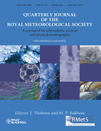
QUARTERLY JOURNAL OF THE ROYAL METEOROLOGICAL SOCIETY
Connecting scholars and practitioners in atmospheric research.The Quarterly Journal of the Royal Meteorological Society, published by Wiley, stands as a prestigious platform in the field of Atmospheric Science, with a commendable impact reflected in its Q1 quartile ranking and a notable Scopus rank of 4th out of 148, placing it in the 97th percentile among its peers. With origins tracing back to 1873, this journal has established itself as a cornerstone for disseminating high-quality research, engaging articles, and innovative methodologies that advance our understanding of meteorological phenomena. Although it is not an open-access journal, the rigorous peer-review process ensures that only the most significant contributions are published, making it essential reading for researchers, professionals, and students dedicated to atmospheric and planetary sciences. For those interested in cutting-edge findings and comprehensive reviews, the Quarterly Journal of the Royal Meteorological Society is an invaluable resource in enhancing scientific knowledge and collaboration in this dynamic and evolving field.

Weather and Climate
Transforming Data into Climate UnderstandingWeather and Climate is a prestigious, peer-reviewed journal published by the Meteorological Society of New Zealand, dedicated to advancing knowledge in the domains of meteorology and climatology. With the ISSN 0111-5499, the journal serves as a vital platform for researchers and professionals to disseminate impactful findings that address pressing issues related to weather patterns and climate change. Although it does not operate on an open-access model, it provides a wealth of valuable insights drawn from a diverse range of studies. The significance of this journal in the scientific community is underscored by its commitment to fostering interdisciplinary collaboration and sharing innovative research that can inform policy-making and environmental management strategies. Located in Wellington, New Zealand, Weather and Climate not only contributes to regional meteorological discourse but also holds relevance for the global scientific landscape, making it essential reading for anyone invested in the future of our changing climate.
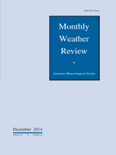
MONTHLY WEATHER REVIEW
Unveiling Insights into Meteorological PatternsMONTHLY WEATHER REVIEW, published by the American Meteorological Society, is a leading journal in the field of atmospheric science, recognized for its rigorous peer-reviewed articles that contribute significantly to the understanding of weather patterns and climate systems. With an impressive Q1 ranking in the 2023 category quartiles and a strong standing (#41 out of 148) in the Earth and Planetary Sciences Scopus rankings, the journal serves as an essential resource for researchers, professionals, and students alike. Although it does not currently offer open access, its comprehensive coverage of meteorological research spanning from 1960 to 2024 makes it invaluable for those seeking to stay at the forefront of developments in weather analysis and prediction. Situated in Boston, Massachusetts, this journal not only showcases pioneering research but also emphasizes the importance of collaborative efforts in the meteorological community, ultimately contributing to advancements in our understanding of atmospheric phenomena.
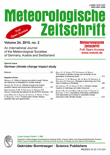
METEOROLOGISCHE ZEITSCHRIFT
Fostering Open Access to Meteorological DiscoveriesMETEOROLOGISCHE ZEITSCHRIFT is a distinguished academic journal dedicated to the field of meteorology and atmospheric sciences, published by E SCHWEIZERBARTSCHE VERLAGSBUCHHANDLUNG. With an ISSN of 0941-2948 and an E-ISSN of 1610-1227, this journal has been an invaluable resource for researchers, professionals, and students since its inception. It has embraced an Open Access model since 2014, promoting wider dissemination of research findings. Based in Stuttgart, Germany, the journal is recognized for its rigorous peer-review process and is currently positioned in the Q3 quartile for Atmospheric Science as per the 2023 category rankings. Additionally, it ranks #97 out of 148 in the Scopus database, placing it in the 34th percentile among Earth and Planetary Sciences. Covering a broad spectrum of topics relevant to meteorology, METEOROLOGISCHE ZEITSCHRIFT serves as a platform for innovative research and theoretical contributions, aiming to advance understanding of atmospheric phenomena and their implications for climate and weather. Researchers and practitioners alike will find valuable insights within its pages, making it a significant asset in the landscape of meteorological scholarship.
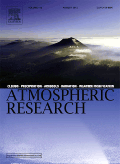
Atmospheric Research
Advancing the Frontiers of Atmospheric ScienceAtmospheric Research is a premier journal published by Elsevier Science Inc, specializing in the field of Atmospheric Science. With a commendable impact factor, it holds a distinguished position in the Scopus rankings, being placed 14th out of 148 journals within its category and achieving a remarkable 90th percentile rank. This journal serves as a vital outlet for rigorous research on atmospheric processes, climate variability, and meteorological phenomena, providing a platform for scientists, researchers, and students to disseminate their findings and contribute to the advancement of knowledge in this critical field. Although it is not an open-access journal, its strong reputation and selective publication criteria ensure that only high-quality and impactful studies are featured. Since its inception in 1986, Atmospheric Research has continuously evolved to meet the dynamic nature of atmospheric studies, making it a fundamental resource for anyone engaged in understanding and addressing atmospheric challenges worldwide.
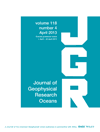
JOURNAL OF GEOPHYSICAL RESEARCH-OCEANS
Pioneering Research in Oceanographic ProcessesJournal of Geophysical Research-Oceans is a premier interdisciplinary journal published by the American Geophysical Union, focused on the dynamic field of ocean sciences. With a rich history dating back to 1986, this journal has become a pivotal platform for researchers, providing a wealth of data and innovative insights into oceanographic processes and their essential role within the Earth's system. The journal enjoys an impressive impact factor and consistently ranks in the Q1 quartile across numerous categories, including Earth and Planetary Sciences and Oceanography, making it a respected source for cutting-edge research and reviews. Notably, it holds significant positions within Scopus rankings, further emphasizing its importance in shaping the scientific discourse surrounding oceanic phenomena. While available through subscription, the Journal of Geophysical Research-Oceans remains an invaluable resource for academics, industry professionals, and students eager to deepen their understanding of ocean dynamics and geophysical interactions.

JOURNAL OF GEOPHYSICAL RESEARCH-ATMOSPHERES
Championing quality research in Earth and planetary sciences.JOURNAL OF GEOPHYSICAL RESEARCH-ATMOSPHERES, published by the American Geophysical Union, is a leading peer-reviewed journal dedicated to advancing our understanding of atmospheric science and related disciplines. With an impressive impact factor and consistently holding a Q1 ranking across key categories including Atmospheric Science and Geophysics, this esteemed journal caters to a global audience of researchers, professionals, and students eager to explore groundbreaking studies and insights. The journal covers a comprehensive scope of topics, from climate dynamics to atmospheric processes, enhancing knowledge and informing practices within the realm of Earth and Planetary Sciences. With its strong emphasis on quality research, it remains a vital resource for those engaged in unraveling the complexities of our planet’s atmosphere. Explore this journal to stay abreast of significant developments and foster a deeper understanding in this ever-evolving field.
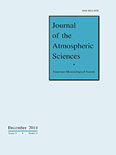
JOURNAL OF THE ATMOSPHERIC SCIENCES
Elevating the Standards of Meteorological ResearchJOURNAL OF THE ATMOSPHERIC SCIENCES, published by the American Meteorological Society, stands as a premier resource for the latest research in atmospheric sciences. With an impressive impact factor and a Q1 ranking in the Atmospheric Science category for 2023, this journal is recognized for its rigorous peer-reviewed articles that contribute to the understanding and advancement of weather, climate, and dynamics of the atmosphere. Established in 1969, the journal has maintained high academic standards and delivers valuable insights spanning over five decades, thus catering to an audience of researchers, professionals, and students alike. Although it does not offer open-access options, it provides critical access through various institutional subscriptions, ensuring that significant research findings are disseminated widely within the scientific community. The journal's address is located at 45 Beacon St, Boston, MA 02108-3693, United States, and it accepts submissions and articles until 2024, continuing its legacy of excellence in atmospheric research.

TELLUS SERIES A-DYNAMIC METEOROLOGY AND OCEANOGRAPHY
Advancing Knowledge in Atmospheric Science and OceanographyTELLUS SERIES A-DYNAMIC METEOROLOGY AND OCEANOGRAPHY, published by Stockholm University Press, is a prestigious open-access journal that has been at the forefront of research in the fields of atmospheric science and oceanography since its inception in 1983. With an enduring commitment to disseminating high-quality, peer-reviewed research, the journal has achieved a commendable impact factor, securing its position in the Q2 category for both Atmospheric Science and Oceanography as of 2023. The journal's significant reach is reflected in its Scopus rankings, being positioned at Rank #51 in Oceanography and Rank #77 in Atmospheric Science. With open access established since 2012, TELLUS SERIES A serves not only as a vital resource for researchers and professionals in these dynamic fields but also as an inclusive platform for budding scholars and students. Engaging with this journal allows readers to stay updated on the latest developments and groundbreaking discoveries that advance our understanding of climate systems and marine environments. Its editorial ethos emphasizes the cross-disciplinary integration of atmospheric and oceanographic studies, making it an essential publication for anyone invested in environmental research and policy.